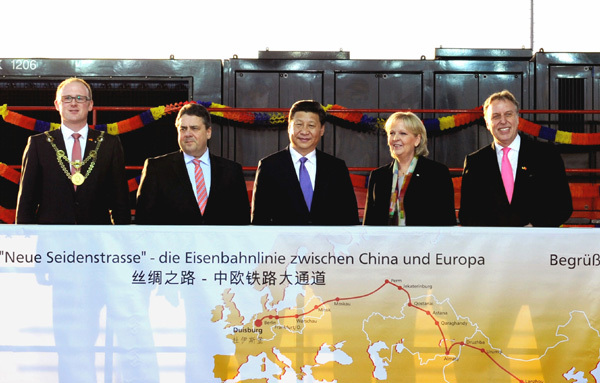'Belt and Road' initiatives new priority
By Ma Chi (chinadaily.com.cn) Updated: 2015-02-02 17:07
 |
|
Chinese President Xi Jinping (center) visits Port of Duisburg of Germany March 29, 2014. [Photo/Xinhua] |
The provincial "two sessions" – the People's Congress and People's Political Consultative Conference – held across the country have shown the increasing commitment of local governments to the "Belt and Road" initiatives, ThePaper.cn reported.
All 28 provinces, autonomous regions and municipalities to have convened meetings voiced in their annual working reports a willingness to take part in the "Belt and Road" initiatives which aim to create new markets for Chinese goods by boosting infrastructure investment in less developed trading partners.
In addition to provinces on the ancient Silk Road such as Shaanxi and Xinjiang, the Inner Mongolia autonomous region and Tibet also want to become part of the plan.
The Tibet autonomous region proposed building a major channel leading to South Asia and an economic belt in the Himalayan region.
By contrast, the enthusiasm of local governments for free trade zones has cooled, with only seven provinces proposing to build them compared with 22 that put forward proposals a year ago.
The "Belt and Road" initiatives – the Silk Road Economic Belt and 21st Century Marine Silk Road – were put forward by Chinese President Xi Jinping during overseas visits in 2013.
The Silk Road Economic Belt is to be established along the ancient Silk Road trade route, which stretches northwest from China's coastal area through Central Asia, the Middle East and on to the Europe, while the 21st Century Marine Silk Road will run through the country's south to South Asia.
Under the initiatives, more highways, railways and air routes will be created and Chinese regions will further integrate resources, policies and markets to connect with the outside world.
- Govt encourages people to work 4.5 days a week
- Action to be taken as HIV cases among students rise
- Debate grows over reproductive rights
- Country's first bishop ordained in 3 years
- China builds Tibetan Buddhism academy in Chengdu
- Authorities require reporting of HIV infections at schools
- Typhoon Soudelor kills 14 in East China
- Police crack down on overseas gambling site
- Debate over death penalty for child traffickers goes on
- Beijing to tighten mail security for war anniversary







